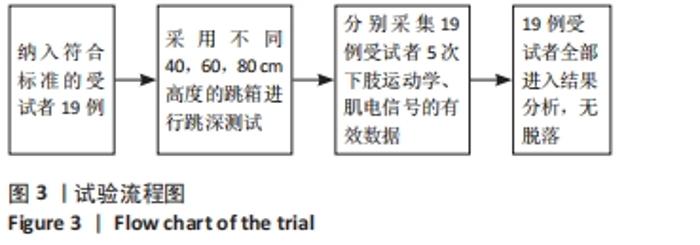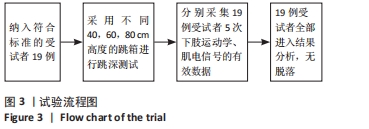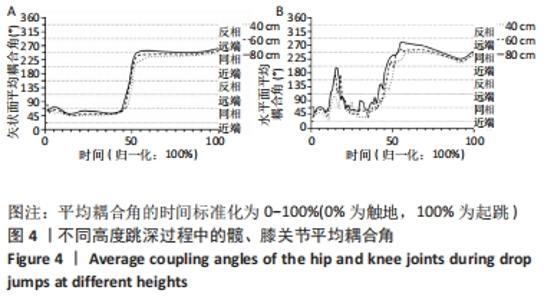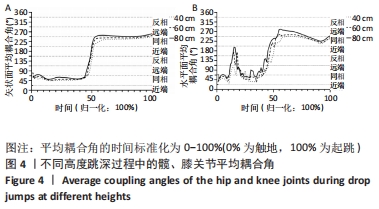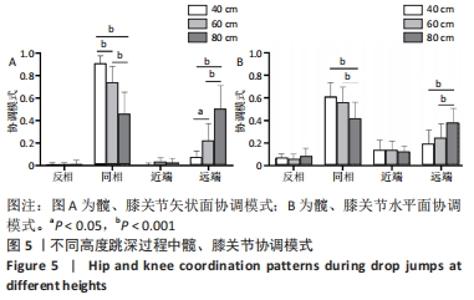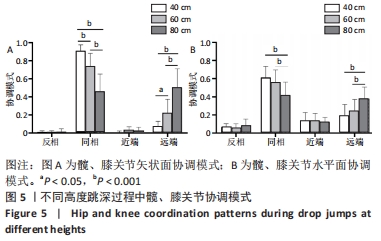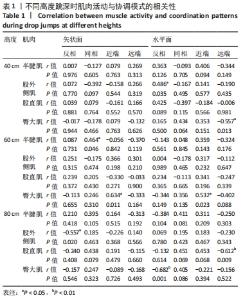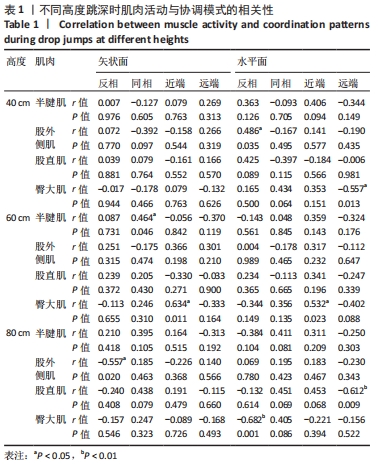Chinese Journal of Tissue Engineering Research ›› 2023, Vol. 27 ›› Issue (2): 276-281.doi: 10.12307/2022.1019
Previous Articles Next Articles
Hip and knee coordination patterns in relation to lower limb muscle activity during drop jumps at different heights
Wang Jiawei, Liu Ye
- Beijing Sport University, Beijing 100084, China
-
Received:2021-12-25Accepted:2022-02-16Online:2023-01-18Published:2022-06-18 -
Contact:Liu Ye, MD, Professor, Beijing Sport University, Beijing 100084, China -
About author:Wang Jiawei, Master candidate, Beijing Sport University, Beijing 100084, China -
Supported by:the Scientific Fitness Guidance Content Project of the General Administration of Sport of China, No. 2017B022 (to LY [project participant]); the Key Laboratory of “Sports and Physical Health” of the Ministry of Education (to LY)
CLC Number:
Cite this article
Wang Jiawei, Liu Ye. Hip and knee coordination patterns in relation to lower limb muscle activity during drop jumps at different heights[J]. Chinese Journal of Tissue Engineering Research, 2023, 27(2): 276-281.
share this article
Add to citation manager EndNote|Reference Manager|ProCite|BibTeX|RefWorks
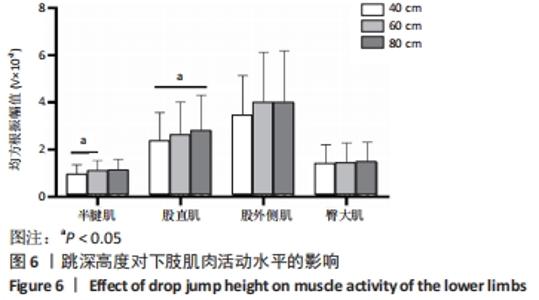
采用单因素重复测量方差分析法判断不同高度跳深对髋、膝关节协调模式百分比的影响。由图4可知,在矢状面中,40 cm与60 cm(P < 0.001)、40 cm与80 cm(P < 0.001)、60 cm与80 cm(P < 0.001)的同相协调模式百分比差异均有显著性意义,40 cm与60 cm(P < 0.05)、60 cm与80 cm(P < 0.001)、40 cm与80 cm(P < 0.001)的矢状面远端协调模式百分比差异均有显著性意义。在水平面中,同相协调仍是最常见的模式,40 cm、60 cm、80 cm分别为(61.21±12.21)%、(56.32±13.39)%和(41.84±14.4)%,其中,40 cm与80 cm(P < 0.001)、60 cm与80 cm(P < 0.001)的水平面同相、远端协调模式百分比差异均有显著性意义。 2.4 不同跳深高度时的肌肉活动 半腱肌肌肉活动在40 cm与60 cm差异有显著性意义(P < 0.05),股直肌肌肉活动在40 cm与80 cm差异有显著性意义(P < 0.05),见图6。 "
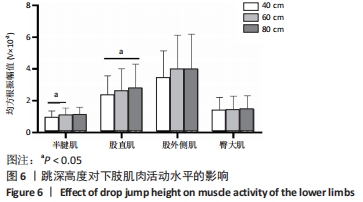
| [1] MAH CD, SPARKS AJ, SAMAAN MA, et al. Sleep restriction impairs maximal jump performance and joint coordination in elite athletes. J Sports Sci. 2019;37(17):1981-1988. [2] KIRKENDALL DT, GARRETT WE JR. The anterior cruciate ligament enigma. Injury mechanisms and prevention. Clin Orthop Relat Res. 2000;37(2):64-68. [3] HOOTMAN JM, DICK R, AGEL J. Epidemiology of Collegiate Injuries for 15 Sports: Summary and Recommendations for Injury Prevention Initiatives. J Athl Train. 2007;42(2):311-319. [4] DEVITA P, SKELLY WA. Effect of landing stiffness on joint kinetics and energetics in the lower extremity. / Effet de la raideur de la reception sur la cinetique et l’ energetique des membres inferieurs. Med Sci Sports Exerc. 1992;24(1):108-115. [5] YU B, GARRETT WE. Mechanisms of non-contact ACL injuries. Br J Sports Med. 2007;41 Suppl 1:i47-51. [6] DICESARE CA, MONTALVO A, FOSS KDB, et al. Sport Specialization and Coordination Differences in Multisport Adolescent Female Basketball, Soccer, and Volleyball Athletes. J Athl Train. 2019;54(10):1105-1114. [7] SINSURIN K, VACHALATHITI R, SRISANGBORIBOON S, et al. Knee joint coordination during single-leg landing in different directions. Sports Biomech. 2020;19(5):652-664. [8] SCHOLZ JP. Dynamic pattern theory--some implications for therapeutics. Phys Ther. 1990;70(12):827-843. [9] CHANG R, VAN EMMERIK R, HAMILL J. Quantifying rearfoot-forefoot coordination in human walking. J Biomech. 2008;41(14):3101-3105. [10] NEEDHAM R, NAEMI R, CHOCKALINGAM N. Quantifying lumbar-pelvis coordination during gait using a modified vector coding technique. J Biomech. 2014;47(5):1020-1026. [11] AKUZAWA H, IMAI A, IIZUKA S, et al. Contribution of the tibialis posterior and peroneus longus to inter-segment coordination of the foot during single-leg drop jump. Sports Biomech. 2020;1-14. doi: 10.1080/14763141.2020.1806347. [12] 井兰香, 刘宇. 不同高度跳深动力学及下肢肌肉预激活调节[J]. 体育科学,2012,32(11):64-69. [13] SCHUSTER RW, PATERNOSTER FK, SEIBERL W. High-density electromyographic assessment of stretch reflex activity during drop jumps from varying drop heights. J Electromyogr Kinesiol. 2020;50: 102375. [14] RAGHAVA NEELAPALA YV, BHAGAT M, SHAH P. Hip Muscle Strengthening for Knee Osteoarthritis: A Systematic Review of Literature. J Geriatr Phys Ther. 2020;43(2):89-98. [15] ARNOLD AS, DELP SL. Rotational moment arms of the medial hamstrings and adductors vary with femoral geometry and limb position: implications for the treatment of internally rotated gait. J Biomech. 2001;34(4):437-447. [16] 田进, 周家颖. 跳深着地阶段下肢所测肌肉的表面肌电活动特征研究[J]. 西安体育学院学报,2009,26(3):341-346. [17] 臧宇, 许贻林, 殷飞, 等. 落地高度对高水平短跑运动员跳深动作下肢生物力学和反应性力量的影响[J]. 体育与科学,2019,40(6): 101-110. [18] PENG HT. Changes in biomechanical properties during drop jumps of incremental height. J Strength Cond Res. 2011;25(9):2510-2518. [19] HAMILL J, HADDAD JM, MCDERMOTT WJ. Issues in quantifying Variability From a Dynamical Systems Perspective. J App Biomech. 2000;16(4):407-418. [20] BUTTON C, WHEAT J, LAMB P. Why coordination dynamics is relevant for studying sport performance. Complex Syst Sport. 2014:44-61. [21] YEOW CH, LEE PV, GOH JC. Sagittal knee joint kinematics and energetics in response to different landing heights and techniques. Knee. 2010; 17(2):127-131. [22] DI GIMINIANI R, GIOVANNELLI A, CAPUANO L, et al. Neuromuscular Strategies in Stretch-Shortening Exercises with Increasing Drop Heights: The Role of Muscle Coactivation in Leg Stiffness and Power Propulsion. Int J Environ Res Public Health. 2020;17(22):8647. [23] TAUBE W, LEUKEL C, LAUBER B, et al. The drop height determines neuromuscular adaptations and changes in jump performance in stretch-shortening cycle training. Scand J Med Sci Sports. 2012;22(5): 671-683. [24] RUIZ-CARDENAS JD, RODRIGUEZ-JUAN JJ, RIOS-DIAZ J. Relationship between jumping abilities and skeletal muscle architecture of lower limbs in humans: Systematic review and meta-analysis. Hum Mov Sci. 2018;58:10-20. [25] PENG HT, KERNOZEK TW, SONG CY. Quadricep and hamstring activation during drop jumps with changes in drop height. Phys Ther Sport. 2011; 12(3):127-132. [26] MRDAKOVIC V, ILIC DB, JANKOVIC N, et al. Pre-activity modulation of lower extremity muscles within different types and heights of deep jump. J Sports Sci Med. 2008;7(2):269-278. [27] KOULOURIS G, CONNELL D. Hamstring muscle complex: an imaging review. Radiographics. 2005;25(3):571-586. [28] BOURNE MN, TIMMINS RG, OPAR DA, et al. An Evidence-Based Framework for Strengthening Exercises to Prevent Hamstring Injury. Sports Med. 2018;48(2):251-267. [29] ARNER JW, MCCLINCY MP, BRADLEY JP. Hamstring Injuries in Athletes: Evidence-based Treatment. J Am Acad Orthop Surg. 2019;27(23):868-877. [30] THELEN DG, CHUMANOV ES, HOERTH DM, et al. Hamstring muscle kinematics during treadmill sprinting. Med Sci Sports Exerc. 2005;37(1): 108-114. [31] LLOYD DG, BUCHANAN TS. Strategies of muscular support of varus and valgus isometric loads at the human knee. J Biomech. 2001;34(10): 1257-1267. [32] KARLSSON E, JONSSON B. Function of the Gluteus Maximus Muscle. An Electromyographic Study. Acta Morphol Neerl Scand. 1965;6:161-169. [33] WALSH M, BOLING MC, MCGRATH M, et al. Lower extremity muscle activation and knee flexion during a jump-landing task. J Athl Train. 2012;47(4):406-413. [34] STEARNS KM, KEIM RG, POWERS CM. Influence of relative hip and knee extensor muscle strength on landing biomechanics. Med Sci Sports Exerc. 2013;45(5):935-941. [35] TOUMI H, POUMARAT G, BENJAMIN M, et al. New insights into the function of the vastus medialis with clinical implications. Med Sci Sports Exerc. 2007;39(7):1153-1159. [36] HERB CC, CHINN L, HERTEL J. Altering Shank-Rear-Foot Joint Coupling During Gait With Ankle Taping in Patients With Chronic Ankle Instability and Healthy Controls. J Sport Rehabil. 2016;25(1):13-22. [37] 杨文燕. 基于矢量编码技术对不同步行速度下肢协调模式的量化分析[D]. 太原:中北大学,2019. [38] 马玉丹, 温朝晖, 具中山, 等. 基于惯性测量单元的女子速度滑冰运动员下肢运动协调特征研究 [J]. 北京体育大学学报,2021,44(12): 98-109. |
| [1] | Wang Jianping, Zhang Xiaohui, Yu Jinwei, Wei Shaoliang, Zhang Xinmin, Xu Xingxin, Qu Haijun. Application of knee joint motion analysis in machanism based on three-dimensional image registration and coordinate transformation [J]. Chinese Journal of Tissue Engineering Research, 2022, 26(在线): 1-5. |
| [2] | Xue Yadong, Zhou Xinshe, Pei Lijia, Meng Fanyu, Li Jian, Wang Jinzi . Reconstruction of Paprosky III type acetabular defect by autogenous iliac bone block combined with titanium plate: providing a strong initial fixation for the prosthesis [J]. Chinese Journal of Tissue Engineering Research, 2022, 26(9): 1424-1428. |
| [3] | Zhuang Zhikun, Wu Rongkai, Lin Hanghui, Gong Zhibing, Zhang Qianjin, Wei Qiushi, Zhang Qingwen, Wu Zhaoke. Application of stable and enhanced lined hip joint system in total hip arthroplasty in elderly patients with femoral neck fractures complicated with hemiplegia [J]. Chinese Journal of Tissue Engineering Research, 2022, 26(9): 1429-1433. |
| [4] | Wu Bingshuang, Wang Zhi, Tang Yi, Tang Xiaoyu, Li Qi. Anterior cruciate ligament reconstruction: from enthesis to tendon-to-bone healing [J]. Chinese Journal of Tissue Engineering Research, 2022, 26(8): 1293-1298. |
| [5] | Shao Yangyang, Zhang Junxia, Jiang Meijiao, Liu Zelong, Gao Kun, Yu Shuhan. Kinematics characteristics of lower limb joints of young men running wearing knee pads [J]. Chinese Journal of Tissue Engineering Research, 2022, 26(6): 832-837. |
| [6] | Zhou Jianguo, Liu Shiwei, Yuan Changhong, Bi Shengrong, Yang Guoping, Hu Weiquan, Liu Hui, Qian Rui. Total knee arthroplasty with posterior cruciate ligament retaining prosthesis in the treatment of knee osteoarthritis with knee valgus deformity [J]. Chinese Journal of Tissue Engineering Research, 2022, 26(6): 892-897. |
| [7] | Xu Kuishuai, Zhang Liang, Chen Jinli, Ren Zhongkai, Zhao Xia, Li Tianyu, Yu Tengbo. Effect of force line changes on lower limb joints after medial open wedge high tibial osteotomy [J]. Chinese Journal of Tissue Engineering Research, 2022, 26(6): 821-826. |
| [8] | Wei Xing, Liu Shufang, Mao Ning. Roles and values of blood flow restriction training in the rehabilitation of knee joint diseases [J]. Chinese Journal of Tissue Engineering Research, 2022, 26(5): 774-779. |
| [9] | Wang Shaoling, Wang Yanxue, Zheng Yaochao, Yu Shaojun, Ma Chao, Wu Shaoling. Feasibility of ultrasound-guided intra-articular injection in rabbit hip joint [J]. Chinese Journal of Tissue Engineering Research, 2022, 26(5): 657-662. |
| [10] | Zhou Liang, Chen Xingzhen, Li Zhenyu, Zhang Zekun, Duan Guoqing. The mechanism of lncRNA HOTAIR in interleukin-1beta-mediated osteoarthritis [J]. Chinese Journal of Tissue Engineering Research, 2022, 26(35): 5607-5613. |
| [11] | Luo Xuehui, Du Shaolong. Relationship between graft diameter and knee function in anterior cruciate ligament reconstruction [J]. Chinese Journal of Tissue Engineering Research, 2022, 26(34): 5482-5485. |
| [12] | Liu Shaohua, Zhou Guanming, Chen Xicong, Xiao Keming, Cai Jian, Liu Xiaofang. Changes in kinematic parameters after unicompartmental knee arthroplasty and high tibial osteotomy [J]. Chinese Journal of Tissue Engineering Research, 2022, 26(3): 390-396. |
| [13] | Li Zhishuai, Zhang Hongqian, Liu Jianquan, Zhang Hankun, Li Li. Visualization analysis of current research hotspots on rehabilitation treatment after anterior cruciate ligament reconstruction [J]. Chinese Journal of Tissue Engineering Research, 2022, 26(26): 4234-4241. |
| [14] | Zhang Xuepu, Wu Yuexin, Zhao Haosen, Ban Zhaoliang, Ma Xiaohu, Tong Gang, Yang Limin. A circular RNA, circ_0040646, regulates the proliferation, differentiation, and apoptosis of knee osteoarthritis chondrocytes by targeted inhibition of microRNA-188-3p [J]. Chinese Journal of Tissue Engineering Research, 2022, 26(20): 3141-3146. |
| [15] | Xia Peige, Yin Li, Wang Haitao, Zhang Yi, Qiao Renqiu, Kong Zhiheng, Zhao Hongbo, Shi Xiangyu. Effect of knee ligamentous laxity on patient satisfaction after total knee arthroplasty: a medium to long-term follow-up [J]. Chinese Journal of Tissue Engineering Research, 2022, 26(15): 2323-2329. |
| Viewed | ||||||
|
Full text |
|
|||||
|
Abstract |
|
|||||
